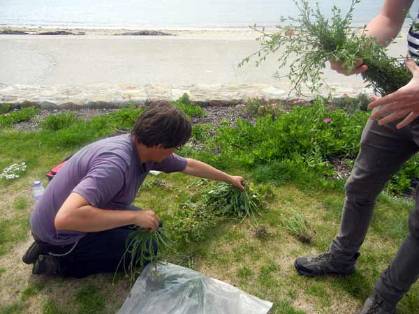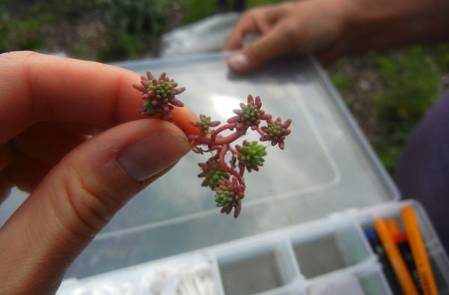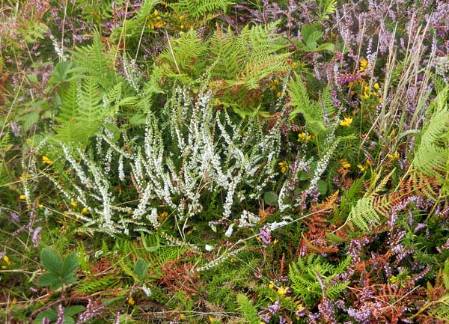At 10am I find Mark Spencer and Jacek Wajer on St. Mary's south beach identifying a plant specimen with a field guide. The Isles of Scilly are the northernmost habitat for a number of plant species, including aeoniums, which originate from the Canary Islands and were introduced in the 1850’s as a garden plant. But it is not the garden plants that Mark and Jacek are interested in, it is the weeds.
While we root around in flower beds by the south beach, local authorities jokingly suggest that they could do with a bit of weeding. "Save us some effort!" they say. Mark tells them about the Museum's work and assures them that we will indeed be helping remove some of the unwanted plants. The three of us continue to nosy around in the flower beds.
 By the south beach on St. Mary's, Mark Spencer approaches weeding with more enthusiasm than most.
By the south beach on St. Mary's, Mark Spencer approaches weeding with more enthusiasm than most.
We find lots of interesting weeds and some fungi, and I find a small succulent weed which Mark says may never have been recorded at St. Mary's before. The specimens we select show a good representation of the whole plant in maturity; flower, leaf, all salient features that are necessary to qualify for the herbarium. The morning’s collections are then bagged and tagged, each labelled with who collected it, the location, the date and the species. It may take up to six months for the specimens to be dried, prepared and mounted on a herbarium sheet, at which point they finally become part of the Museum’s collections.
Unidentified succulent weed found by Gemma Anderson in a flower bed near St. Mary's beach. A possible first record of this species for the area.
We then carry the bagged plants back to base for sorting. Delicate specimens are prioritised, and the specimens are left to wilt overnight in a flower press until herbarium paper is brought on Monday.
At 4pm we leave the base and walk to the east of St. Mary's, plant spotting in hedges along the way. Jacek spots another possible new plant record for the Isles of Scilly, and we immediately press the specimen in my sketchbook before continuing along footpaths, small lanes, fields and coastal paths. We finally come to gorse land in wave formations, a micro landscape which Mark tells us is an endangered environment. There is an unusual mix of white and purple heather and a folkloric atmosphere as a rainbow emerges overhead.
An unusual mix of white and purple heather on the Heathland, St.Marys.
I ask Mark if the walk is part of his method: to orientate, to locate, and to formulate ideas and questions. He replies ‘yes, very much so’. I had taken an observational walk the evening before for the very same reasons; as artist and scientist, this method is essential to the beginning of our fieldwork.
Posted on behalf of Gemma Anderson, an artist and PhD researcher who accompanied Musuem scientists on a field work trip to the Isles of Scilly between 17 and 23 August 2013.




